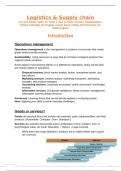Logistics & Supply chain
(is mix boek, ppts en nota’s dus ja beke wirwar bwahahaha)
(bijna volledig int Engels naast beke uitleg bij formules en
oefeningen)
Introduction
Operations management
Operations management is the management of systems or processes that create
goods and/or provide services.
Sustainability: Using resources in ways that do not harm ecological systems that
support human existence.
Every aspect of aa business affects or is affected by operations. Many service jobs
are closely related to operations
- Financial services (stock market analyst, broker, investment banker, and
loan officer)
- Marketing services. (market analyst, marketing researcher, advertising
manager, and product manager)
- Accounting services. (corporate accountant, public accountant, and budget
analyst)
- Information services. (Corporate intelligence, library services, management
information systems design services).
Previously: Learning theory that can be directly applied to achieving results.
Now: Applying your skills to tackle everyday challenges.
Goods or services?
Goods are physical items that include raw materials, parts, subassemblies, and final
products: (Automobile. Computer. Oven. Shampoo.)
Services are activities that provide some combination of time, location, form, or
psychological value: Air travel. Education. • Haircut. • Legal counsel)
- While these are rough definitions, products are in reality neither pure a good
nor a service.
2
,Supply chain
Supply chain is a sequence of organizations, their facilities, functions, and activities
that are involved in producing and delivering a product or service.
2
, - Retailer consumer/customer is the only B2C relation in this chain, all the
rest are B2B.
- While most B2B companies are unknown to the consumer, for the most part
this isn’t that big of a deal for them (mainly product dependent). There’re still
those who still do marketing to promote their products, you just don’t but their
products non-directly (Nutella advertises their products but you buy them from
Colruyt)
Supply chain management
In the past, businesses did little to manage the supply chain beyond their own
operations and immediate suppliers, which led to numerous problems:
SCM = The strategic coordination of the supply chain for the purpose of integrating
supply and demand management.
- Oscillating inventory levels. Frequent fluctuations in inventory amounts due
to demand changes, forecasting errors, or supply chain issues.
- Inventory stock-outs. Running out of stock, preventing fulfillment of
customer orders or production needs.
- Late deliveries.
- Quality problems.
Supply chain in 2024
Covid broke supply chains, but how?
- Supply: During lockdowns, factories and suppliers halted or slowed
operations as workers stayed home. This caused supply shortages for weeks
or months.
Lagging recovery: Once the lockdowns eased: workers returned to
stabilize production, but catching up with demand took time.
- Delivery: Mix off multiple problems: workers stayed home, border & lockdown
restrictions which caused delays. On the other hand, there’s also the surge of
e-commerce which overwhelmed delivery networks, and such caused a
bigger problem
- Demand: the demand was also product-dependent, toilet paper and such had
a spike in demand, off which factories couldn’t keep up.
Covid redesigned SCM: All of this has caused a shift in the way that businesses
thought about SCM, they were searching for alternatives so they could act better for
future crisis. There was a shift from linear supply chain to more integrated
networks. More focused on environmental and sustainability goals. Race is on for
digital enablement and automation
- Risk of indispensable parts of the global supply chain.
2
, Anything with electronics needs a microchip, the problem is that 90% of
the production comes from Taiwan.
A shift towards integrated networking, has caused a shortening of supply chains
This approach fosters stronger relationships and collaboration, enhances resilience,
improves food security, and lowers carbon emissions which all is equally appealing
to both businesses and consumers.
≠ reducing the number of steps or players. But rather integrating them within a
single entity. Nike consolidates its supply chain by operating as a
manufacturer, distributor, and retailer. By selling products directly through its
own stores or online platforms, which eliminates the need for multiple
intermediaries, and allows them to retain more profits and exercise greater
control over the entire process, enhancing their market position.
Elements of supply chain management
Central to this is taking customer demand and translating it into corresponding
activities at each level of the supply chain.
Predicting the quantity and timing of customer
Forecasting
demand
Capacity management Matching supply and demand
Meeting demand requirements while managing the
Inventory
costs of holding inventory
Evaluating potential suppliers, supporting the needs
Purchasing
of operations on purchased goods and services
Deciding how to best move information and
Logistics
materials
Enterprise resource Creation of a software/platform, that benefits the
planning customer
Difference between logistics and supply chains? Is supply chain management the
“new” logistics? Is logistics = SCM? NO!
Logistics is the movement, storage and flow of goods, services and information
within overall supply chain
2




